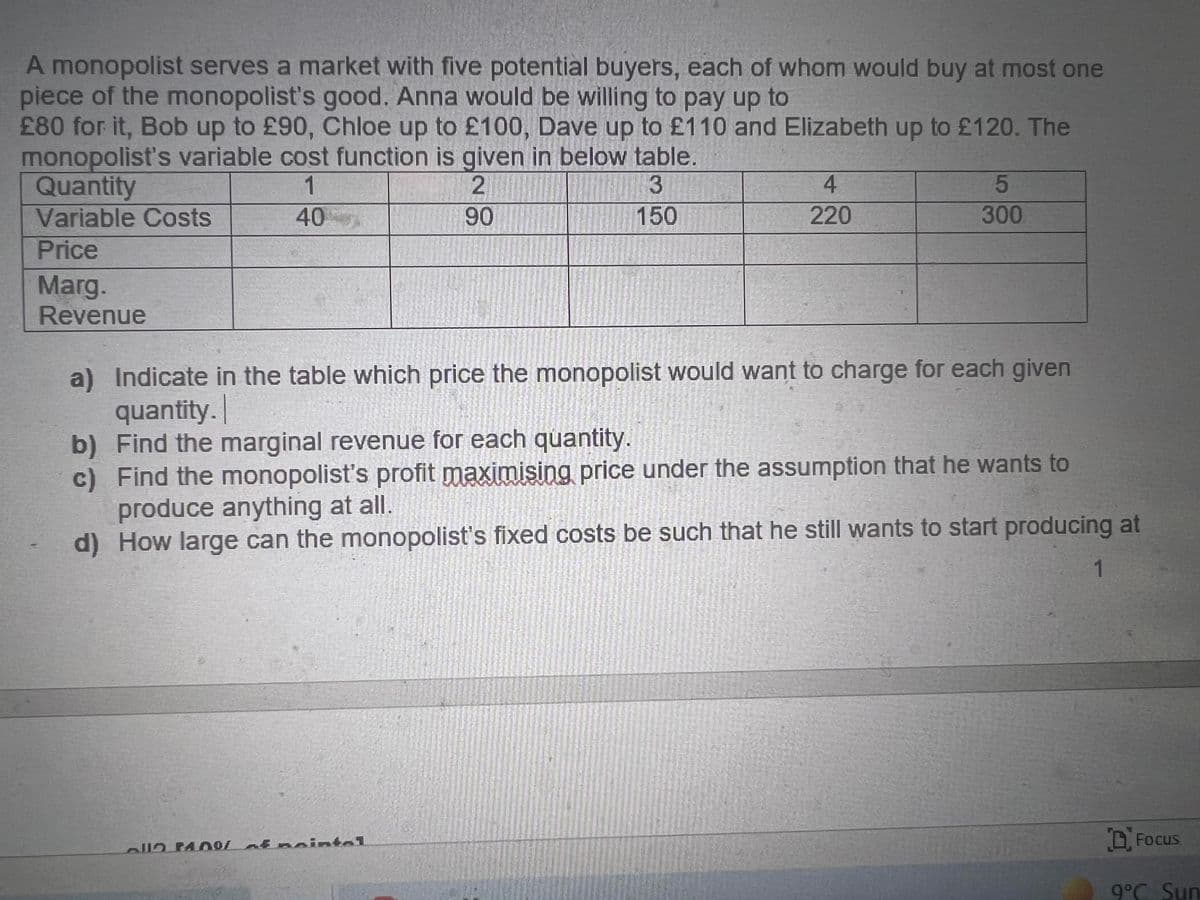A monopolist serves a market with five potential buyers, each of whom would buy at most one piece of the monopolist's good. Anna would be willing to pay up to £80 for it, Bob up to £90, Chloe up to £100, Dave up to £110 and Elizabeth up to £120. The monopolist's variable cost function is given in below table. Quantity Variable Costs Price 1 2 3 4. 40 90 150 220 300 Marg. Revenue a) Indicate in the table which price the monopolist would want to charge for each given quantity. b) Find the marginal revenue for each quantity. c) Find the monopolist's profit maximising price under the assumption that he wants to produce anything at all.
A monopolist serves a market with five potential buyers, each of whom would buy at most one piece of the monopolist's good. Anna would be willing to pay up to £80 for it, Bob up to £90, Chloe up to £100, Dave up to £110 and Elizabeth up to £120. The monopolist's variable cost function is given in below table. Quantity Variable Costs Price 1 2 3 4. 40 90 150 220 300 Marg. Revenue a) Indicate in the table which price the monopolist would want to charge for each given quantity. b) Find the marginal revenue for each quantity. c) Find the monopolist's profit maximising price under the assumption that he wants to produce anything at all.
Micro Economics For Today
10th Edition
ISBN:9781337613064
Author:Tucker, Irvin B.
Publisher:Tucker, Irvin B.
Chapter13: Antitrust And Regulation
Section: Chapter Questions
Problem 10SQP
Related questions
Question

Transcribed Image Text:A monopolist serves a market with five potential buyers, each of whom would buy at most one
piece of the monopolist's good. Anna would be willing to pay up to
£80 for it, Bob up to £90, Chloe up to £100, Dave up to £110 and Elizabeth up to £120. The
monopolist's variable cost function is given in below table.
Quantity
Variable Costs
1
3.
4.
40
90
150
220
300
Price
Marg.
Revenue
a) Indicate in the table which price the monopolist would want to charge for each given
quantity.
b) Find the marginal revenue for each quantity.
c) Find the monopolist's profit maximising price under the assumption that he wants to
produce anything at all.
d) How large can the monopolist's fixed costs be such that he still wants to start producing at
1.
D Focus
9°C Sun
Expert Solution
This question has been solved!
Explore an expertly crafted, step-by-step solution for a thorough understanding of key concepts.
Step by step
Solved in 2 steps

Knowledge Booster
Learn more about
Need a deep-dive on the concept behind this application? Look no further. Learn more about this topic, economics and related others by exploring similar questions and additional content below.Recommended textbooks for you








Managerial Economics: A Problem Solving Approach
Economics
ISBN:
9781337106665
Author:
Luke M. Froeb, Brian T. McCann, Michael R. Ward, Mike Shor
Publisher:
Cengage Learning

Economics (MindTap Course List)
Economics
ISBN:
9781337617383
Author:
Roger A. Arnold
Publisher:
Cengage Learning